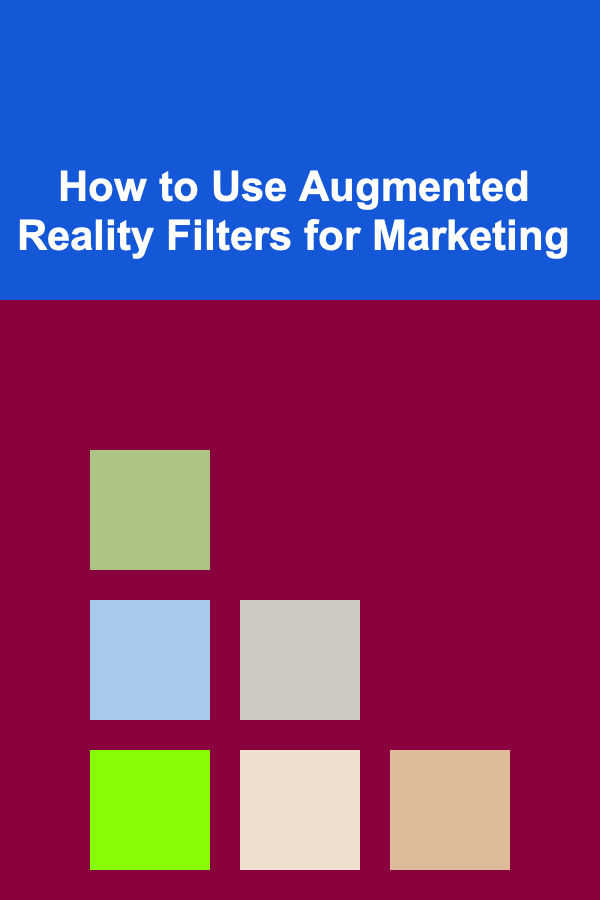
How to Use Augmented Reality Filters for Marketing
ebook include PDF & Audio bundle (Micro Guide)
$12.99$6.99
Limited Time Offer! Order within the next:

Augmented Reality (AR) has taken the world by storm, and its applications are only becoming more widespread. One of the most exciting ways businesses are using AR is through filters. These digital overlays can be applied to images and videos in real time, enhancing the viewer's experience and creating engaging content. While originally popularized by social media apps like Snapchat and Instagram, AR filters have quickly become a powerful marketing tool. This article will dive deep into how AR filters can be used for marketing, how they can enhance customer engagement, and how businesses can leverage this technology to increase brand visibility and consumer interaction.
What Are Augmented Reality Filters?
Augmented Reality filters are digital effects that are superimposed on real-world environments, often through the camera on a smartphone, tablet, or specialized glasses. These filters can alter the user's environment by adding objects, altering their appearance, or changing the context in which they view their surroundings. The filters are often used for entertainment, artistic expression, or functional purposes, and they are most commonly integrated into apps such as Instagram, Snapchat, and TikTok.
In marketing, AR filters serve as an engaging way to interact with consumers, provide unique experiences, and increase brand recognition. These filters can be customized to align with a company's branding, campaigns, or messages, creating a seamless connection between the brand and the consumer.
How AR Filters Benefit Marketing Campaigns
Augmented Reality filters offer a range of benefits for marketers. Some of these advantages include:
1. Enhanced Consumer Engagement
The interactive nature of AR filters encourages users to engage with the brand in a fun and creative way. By using AR filters, consumers become active participants in the marketing experience, rather than passive observers. This type of engagement can significantly improve brand recall, as customers are more likely to remember a brand that provided them with a personalized, immersive experience.
2. Brand Awareness and Reach
AR filters are highly shareable. When users apply an AR filter, they often share their photos and videos on social media, which amplifies the brand's visibility. Since filters are typically used on platforms like Instagram and Snapchat, which are built for sharing visual content, the potential for organic reach is vast. Every time a user shares content featuring a branded AR filter, they are exposing the brand to their entire network, increasing its reach exponentially.
3. Personalization
AR filters allow businesses to create personalized experiences for their customers. Whether it's a filter that changes a user's appearance to reflect a specific theme, adds a company logo to the background, or interacts with the environment in real-time, AR filters create a sense of exclusivity and individualization. Personalized content resonates with consumers, making them feel more connected to the brand.
4. Improved Customer Experience
AR filters can enhance the customer experience by offering them something new and interactive. Rather than simply showing them an ad or a product, a well-designed AR filter invites them to experience the brand in a new way. For instance, a furniture retailer might create a filter that allows customers to see how a couch would look in their living room, or a cosmetics brand might let users try on makeup virtually.
5. Innovative Storytelling
AR filters can help brands tell stories in ways that traditional media cannot. Through AR, brands can create dynamic, layered experiences that go beyond the limitations of static content. By combining visual effects, audio, and interactivity, brands can develop narratives that engage users on a deeper level. Storytelling via AR can evoke emotions, generate excitement, and create memorable experiences that leave a lasting impact on the consumer.
How to Use AR Filters in Marketing
There are several ways to incorporate AR filters into a marketing strategy. Here are some effective methods:
1. Branded Filters on Social Media Platforms
The most common way to use AR filters in marketing is through social media platforms. Brands can design and launch custom filters that users can apply to their photos and videos. These filters could range from simple logos to complex animations or interactive designs.
Snapchat and Instagram Filters
Snapchat was the pioneer in AR filters, and it remains one of the most popular platforms for brands to use this technology. Snapchat offers a feature called "Lenses," which brands can create and promote. Brands can encourage users to share content with their filters and offer rewards or incentives for participation. Instagram has followed suit with its AR filters and lets users apply filters directly in Stories or in their feed. Brands can develop filters that encourage users to tag them, share their content, or use branded hashtags.
Creating Interactive Filters
To make filters more engaging, businesses can add interactive elements to their designs. For example, an AR filter might ask users to perform a specific action, such as smiling, waving, or moving the phone in a certain direction. These interactive elements make the experience more fun and engaging, increasing the likelihood that users will share the content.
2. Influencer Collaborations and User-Generated Content
Partnering with influencers is another effective way to leverage AR filters in marketing. Influencers already have a large, engaged audience, and by working with them to promote branded AR filters, businesses can amplify their reach. Influencers can create unique, customized filters that align with their brand identity, and in turn, their followers will be encouraged to use these filters as part of their daily social media activity.
User-generated content (UGC) is another powerful marketing tool. When customers use AR filters and share content online, it becomes a form of organic advertising. Brands can encourage users to create and share their own content by offering incentives like discounts, giveaways, or featuring the best user-generated posts on the brand's official social media pages.
3. AR Filters for Product Try-Ons
The virtual try-on experience is becoming increasingly popular, especially in the fashion and beauty industries. AR filters allow consumers to try products before they make a purchase, which can significantly boost their confidence in their buying decisions.
Beauty and Cosmetics
Cosmetic brands, such as Sephora and L'Oréal, have already embraced AR technology by allowing users to try on makeup virtually. Through a filter, consumers can see how a lipstick shade or eyeshadow looks on their face, helping them decide which products to purchase. This personalized experience enhances customer satisfaction and drives sales by making it easier for consumers to envision themselves using the product.
Fashion and Apparel
For fashion brands, AR filters can provide a virtual dressing room experience. Consumers can see how clothing items or accessories look on them in real-time, without ever stepping into a store. Virtual try-on features reduce the uncertainty of purchasing clothing online, which can lead to increased conversion rates.
4. AR Filters for Event Marketing
Brands can also use AR filters to promote events, product launches, or special promotions. For example, an event-specific filter can create a sense of exclusivity and encourage social media sharing. Attendees of a concert or trade show can use an AR filter to capture their experiences and share them with their networks, further promoting the event or brand. This increases both visibility and engagement with the target audience.
5. Gamification with AR Filters
Gamification is a powerful tool in marketing, and when combined with AR filters, it can create highly interactive and engaging experiences. By incorporating game-like elements into AR filters, businesses can encourage users to complete certain tasks, collect points, or participate in challenges. For example, a brand could create an AR scavenger hunt, where users must find hidden objects in their surroundings or perform specific actions to unlock rewards or exclusive content.
6. AR Filters for Location-Based Marketing
AR filters can also be used in conjunction with location-based marketing strategies. For example, a brand could create a filter that only works in specific geographic areas, encouraging users to visit certain locations in order to unlock the filter. This could work well for retail stores, restaurants, or tourism campaigns. By linking the AR filter to a physical location, businesses can increase foot traffic and drive in-person sales.
How to Create Effective AR Filters for Marketing
Creating AR filters requires a combination of creativity and technical expertise. To ensure that your AR filter is both effective and engaging, follow these key steps:
1. Align with Brand Identity
Your AR filter should reflect your brand's personality and messaging. Whether it's a filter with your logo, a filter that represents your product, or a fun, interactive experience, make sure it aligns with your brand's image and values.
2. Keep It Simple and Intuitive
While AR filters offer a lot of creative freedom, it's important to keep them simple and user-friendly. Overly complex filters can confuse users and lead to a lack of engagement. Make sure the filter is easy to use and immediately enjoyable.
3. Make It Fun and Interactive
The best AR filters are those that users enjoy interacting with. Try to incorporate interactive features that invite users to take action, whether it's through a game, a challenge, or something they can share with their friends. The more engaging the filter, the more likely it is that users will share it.
4. Optimize for Performance
Make sure your filter runs smoothly on different devices and operating systems. Poor performance or lag can ruin the user experience and negatively impact your brand's reputation. Test your filter thoroughly before launching it to ensure it performs well across a variety of conditions.
5. Monitor Performance and Iterate
Once your AR filter is live, track its performance using analytics tools. See how often it's being used, how many people are sharing it, and how it's contributing to your overall marketing goals. Use this data to refine your filters and create even better experiences in the future.
Conclusion
Augmented Reality filters offer businesses an innovative and engaging way to connect with consumers. By leveraging AR filters, companies can boost brand awareness, enhance customer engagement, and create memorable, shareable experiences that resonate with their target audience. Whether it's through social media campaigns, product try-ons, or gamified interactions, AR filters offer endless possibilities for creative marketing strategies. As AR technology continues to evolve, businesses that adopt and experiment with these tools will be at the forefront of a new era in digital marketing.

How to Incorporate Statement Lighting Fixtures into Your Home
Read More
How to Keep Your Home Secure While on Vacation
Read More
How To Understand the Concept of Eudaimonia (Flourishing)
Read More
How to Upgrade Your Home's Security Without Drilling Holes
Read More
The Ultimate Guide to Utilizing Online Marketplaces for Buying and Selling Goods
Read More
How to Design a Daily Routine Checklist for Students with ADHD
Read MoreOther Products

How to Incorporate Statement Lighting Fixtures into Your Home
Read More
How to Keep Your Home Secure While on Vacation
Read More
How To Understand the Concept of Eudaimonia (Flourishing)
Read More
How to Upgrade Your Home's Security Without Drilling Holes
Read More
The Ultimate Guide to Utilizing Online Marketplaces for Buying and Selling Goods
Read More